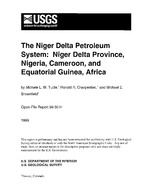In the Niger Delta province, we have identified one petroleum system--the Tertiary Niger Delta (Akata-Agbada) petroleum system. The delta formed at the site of a rift triple junction related to the opening of the southern Atlantic starting in the Late Jurassic and continuing into the Cretaceous. The delta proper began developing in the Eocene, accumulating sediments that now are over 10 kilometers thick. The primary source rock is the upper Akata Formation, the marine-shale facies of the delta, with possibly contribution from interbedded marine shale of the lowermost Agbada Formation. Oil is produced from sandstone facies within the Agbada Formation, however, turbidite sand in the upper Akata Formation is a potential target in deep water offshore and possibly beneath currently producing intervals onshore.
Known oil and gas resources of the Niger Delta rank the province as the twelfth largest in the world. To date, 34.5 billion barrels of recoverable oil and 93.8 trillion cubic feet of recoverable gas have been discovered. In 1997, Nigeria was the fifth largest crude oil supplier to the United States, supplying 689,000 barrels/day of crude.


